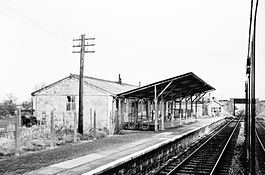Carterton (Oxfordshire) railway station
| Carterton | |
|---|---|

January 1962
|
|
| Location | |
| Place | Carterton |
| Area | West Oxfordshire |
| Coordinates | 51°44′28″N 1°35′16″W / 51.74104°N 1.58766°WCoordinates: 51°44′28″N 1°35′16″W / 51.74104°N 1.58766°W |
| Grid reference | SP286048 |
| Operations | |
| Original company | Great Western Railway |
| Post-grouping | Great Western Railway |
| Platforms | 2 |
| History | |
| 2 October 1944 | Station opens |
| 18 June 1962 | Station Closes |
| Disused railway stations in the United Kingdom | |
| Closed railway stations in Britain A B C D–F G H–J K–L M–O P–R S T–V W–Z |
|
|
|
|
| Oxford, Witney and Fairford Railway | |||||||||||||||||||||||||||||||||||||||||||||||||||||||||||||||||||||||||||||||||||||||||||||||||||||||||||||||||||||||||||||||||||||||||||||||||||||||||||||||||||||||||
|---|---|---|---|---|---|---|---|---|---|---|---|---|---|---|---|---|---|---|---|---|---|---|---|---|---|---|---|---|---|---|---|---|---|---|---|---|---|---|---|---|---|---|---|---|---|---|---|---|---|---|---|---|---|---|---|---|---|---|---|---|---|---|---|---|---|---|---|---|---|---|---|---|---|---|---|---|---|---|---|---|---|---|---|---|---|---|---|---|---|---|---|---|---|---|---|---|---|---|---|---|---|---|---|---|---|---|---|---|---|---|---|---|---|---|---|---|---|---|---|---|---|---|---|---|---|---|---|---|---|---|---|---|---|---|---|---|---|---|---|---|---|---|---|---|---|---|---|---|---|---|---|---|---|---|---|---|---|---|---|---|---|---|---|---|---|---|---|---|---|
|
|||||||||||||||||||||||||||||||||||||||||||||||||||||||||||||||||||||||||||||||||||||||||||||||||||||||||||||||||||||||||||||||||||||||||||||||||||||||||||||||||||||||||
Carterton railway station was a railway station just north of the village of Black Bourton on the Oxford, Witney and Fairford Railway between Oxford and Fairford. The station had two stone-built platforms, a passing loop, and a concrete station building.
Built next to the Carterton to Black Bourton road less than two miles from Brize Norton and Bampton railway station, the station was opened on 2 October 1944, to serve RAF Brize Norton which had opened in August 1937. It had initially been considered to name the station "Black Bourton".
Construction of the station had begun in May 1944 when a siding was laid on the Down side which, three months later, was adapted as a passing loop opened on 10 August, 18 chains (360 m) in length and fully signalled for passenger services. The station had platforms on the Up and Down lines; an austere War Department-type structure resembling an RAF hut, stood on the Up side. The front of the building was sheltered by a makeshift asbestos canopy and a traditional timber signal box stood just beyond the end of the Up platform. A very basic corrugated iron shelter was provided on the Down platform. No goods facilities were provided as Brize Norton and Bampton station lay within close proximity 1 mile 32 chains (2.3 km) to the east, although agricultural produce from smallholdings in Carterton were often dispatched by passenger train.
The position of the line in relation to the airfield meant that when its facilities were extended southwards, two essential taxiways crossed the railway line necessitating wide level crossing gates to span the entire width. After the war, the airfields continued to generate significant traffic until the early 1950s when Brize Norton became a USAF base and traffic suddenly fell away. By June 1958 there was only one daily freight service on the line: a morning working from Carterton to Oxford.
...
Wikipedia
